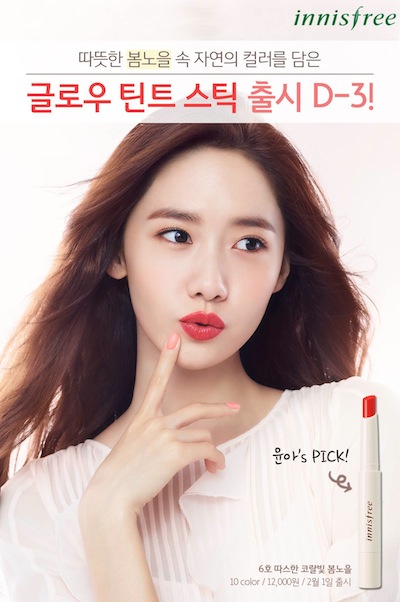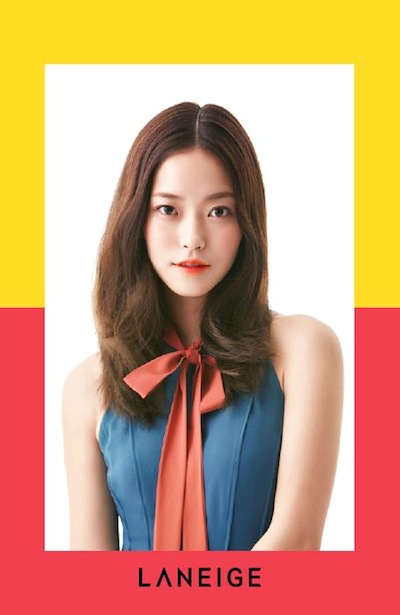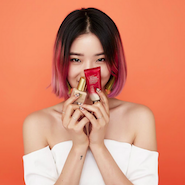The slowing of China’s economy has afforded neighboring countries such as South Korea an opportunity to become a tourist destination, which in effect has brought increased exposure to the country’s products.
South Korean beauty products in particular have seen a rise in popularity, at the expense of Western brands who entered the Chinese market when the playing field was more fruitful. According to L2’s “The Beauty China: The Rise of Korean Brands” Insight Report, Western skincare and color cosmetics have seen share erosion while interest in South Korean beauty is skyrocketing, now accounting for nearly a quarter of cosmetic imports to China.
"South Korea is the source of innovation for the beauty industry," said Danielle Bailey, research director at L2, New York. "The hottest products in recent years including bb cream and cushion compacts that Western brands have copied, originated in South Korea.
"South Korean products are perfectly positioned for the current climate, with excellent price to value ratios and often touting natural ingredients," she said.
"Both online and offline Korean brands are expanding their reach. Beauty bloggers and vloggers always on the hunt for the next thing have already begun to feature South Korean products, introducing them to a global audience."
My lipgloss is K-Poppin’
From fashion magazines to beauty bloggers, South Korean-made products have taken the cosmetic industry by storm. With innovative products and ingredients along with mid-range pricing and the influence of K-Pop celebrities, the value of South Korean products being imported to China has increased by more than 250 percent.
Accounting for nearly a quarter of cosmetics imported to China, South Korean beauty’s impact on the Chinese market is up 126 percent from the year-ago.
As South Korean beauty has increased in popularity and demand, Western brands have seen a slow decline in interest among China’s population. Skincare and color cosmetics have witnessed a 4.8 percent and 3.8 percent decline, respectively in 2014.
Beyond innovative products, South Korean beauty brands are also excelling online, giving Chinese brand sites “much needed facelifts” by incorporating functionality and content that drives loyalty, trial and ecommerce. With similar cultures, South Korean beauty brands may have better luck infiltrating the Chinese market in ways that Western brands have yet to master.
To this point, European- and United States-based beauty brands’ digital IQ dipped in China. But in comparison, Korean brands saw an average 18 percent year-over-year digital IQ growth and local Chinese brands only 2 percent.

Estée Lauder's ecommerce site for South Korea
L2 found that Korean brands’ indexes on popular Chinese search platforms Baidu and Weibo are more than 1.5 and 4 times the index average, respectively. This finding reflects popularity and purchase intent across search, social and ecommerce platforms.
South Korea’s Innisfree beauty brand leads the pack on Baidu an index of 11,194, and a year-over-year growth of 89 percent. Western brands dominate the top 10 Baidu index with Kiehl’s, Estée Lauder, LVMH-owned Sephora and Lancome placing.
On Weibo, South Korean brand Laneíge leads all brands with more than 2,100 average monthly mentions on the platform. When looking at Weibo, South Korean beauty is the subject of 42 times the conversations than the Index average, showing the platform’s ability to provide additional earned media and sentiment.
L2 also considered Chinese marketplaces Taobao, owned by Alibaba, and Tmall, where Innisfree and Laneíge are among the top 10 most-searched for brands. These South Korean brands share the top 10 with Western brands such as L’Oreal Paris, Chanel and Estée Lauder as well as local brands and Japan’s Shiseido.
As with many industries, L2 found that there is still room for ecommerce, SEO and social commerce improvements to be made. Increasing focus in these areas will allow South Korean beauty brands to secure better positioning in the Chinese beauty market.
Western and South Korean beauty brands should consider the marketing success of Innisfree and Laneíge when formulating strategy for the Chinese consumer.

Innisfree lipstick campaign
L2 cites Innisfree as “leading the pack” due to its lead in search volume on Baidu, Taobao and Youku. Innisfree maintains a direct-to-consumer brand site with a cross-channel loyalty program, video libraries and user-generated content aggregated from social media. The brand also offers a mobile-optimized Web site and mobile exclusives.
Last spring, Innisfree cast South Korean influencers Lee Minho and Yoona for the “Summer Love” cross-channel campaign for its Summer Foundation Cushion product. The campaign featured five videos that told a love story, two of which became the brand’s most viewed with an average of 181,000 views.
Innisfree rounded out the campaign with social content including a WeChat post that saw 10,600 thousand views. Also, the campaign’s #Innisfree夏日恋曲 hashtag, had 17.7 million impressions and 36,000 mentions on Weibo.
Laneíge is similarly digital-savvy, expanding its reach through content-based efforts found on WeChat and Youku. On these social platforms Laneíge has seen 7 and 3 times the views on the index average.

Laneíge dual-color lipstick campaign
The brand’s most successful effort on Youku was “Fashion in Seoul,” a video which garnered approximately 2 million views. Fashion in Seoul showed the protagonist using WeChat, allowing for cross-platform inclusion.
This was followed up by South Korean drama “Descendents of the Sun” in March 2015. Starring Kang Mo Yeon, Laneíge’s spokesmodel since 2008, the online show has reached 440 million viewers in China.
Laneíge has also been successful in ecommerce and search. The beauty brand holds 25 percent of mobile organic brand term search results, compared to the 16 percent average in the category. Similarly, Laneíge’s average number of followers on Tmall is 3 times the average, and double the average on mobile.
The South Korean beauty market is not only seeing a spike in interest in China, but also in North America.
"We are starting to see Korean vertical retailers expand beyond their borders," Ms. Bailey said. "Nature Republic opened its first company operated flagship store in New York's Union Square earlier this year.
"This marks the first time the brand has opened a store in a non-Asian neighborhood in North America," she said. "Other South Korean brands are likely to follow.
"In the retail environment, from a product knowledge, customer service, consultative sales and selection perspective, Korean brands also have an advantage."
Joining the party
South Korea’s popular culture, brands and blazing Internet speeds are propelling the country into territory that has long been occupied by the United States, according to L2’s founder at the L2 Forum 2014.
Whether it is a multinational beauty brand taking cues from South Korean labels or Seoul’s rapid climb up the luxury mountain, the Northeast Asian country is disrupting global dynamics on a few fronts (see story).
L2’s predictions from 2014 are proving to be true with the beauty sector and high-end fashion taking note.
Beauty marketer Estée Lauder Cos., for instance, strengthened its presence in South Korea by purchasing an interest in Have & Be Co. Ltd’s Dr. Jart+ and Do The Right Thing.
The investment in South Korean skincare brands will keep Estée Lauder on the cutting edge of the country’s beauty innovation and trends. The investment will also help Estée Lauder increase its presence in Asia and capitalize on a growing South Korean beauty wave ahead of a potential global flourish (see story).

BB creams by South Korea's Dr. Jart+
In the fashion sector, France’s Christian Dior expressed its commitment to South Korean consumers with its first boutique in the country’s capital.
Dior promoted its Seoul boutique both on social media and its branded blog DiorMag leading up to the store’s opening June 2015, along with its traveling exhibit “Esprit Dior” which landed in South Korea at the same time. As China begins to simmer, luxury houses are looking elsewhere in Asia, such as South Korea and Japan, to tap into affluent consumers as other emerging markets begin to develop and stabilize (see story).
Western beauty brands vying for Chinese interest may be able to learn from successful South Korean labels.
"We believe that South Korean brands digital performance and investments are forward looking indicators of market success," Ms. Bailey said. "To compete Western brands should leverage the popularity of South Korean and identify South Korean acquisition targets to add to their portfolios.
"Western brands should also re-prioritize their digital investment strategies," she said. "Often operating with a 'what works here will work in China' mentality, many Western brands have focused on building sophisticated brand sites and traditional search engine optimization and marketing, despite most Chinese purchase and search activity occurring on ecommerce platforms such as Tmall, JD.com and Jumei."
{"ct":"mbjTfRp00XVetjIK5qXPIL\/KFKLP2MSJ5JPxFZPwbETuP+WBpsJszBR3OwX79jD2JTSspb6ErA5R+3fjZYrl6JQuP0xUMeoI29l\/JX1eig\/\/dnUbLex79QW+0UrNjRBOduc4NXymcBZlhjucbq6ytpHOexJrGcZi0qMA0Tazd6eWwE6qktdceZYM+kVzw2NSlm9xNok61xr+jTq4BhjzLGwl4Q669NC4gd2lQHDh35fW+RhGr7qoWSiPwHhMJNXl++L+z4MG+llI\/GGGSWd3hOb2XuZXjqtQTIYv8lQimpJHeosE4dxtsRz7w13alH\/XUjEJFDTXxR06BQvsFO1jo\/1m9wPTmRGgi5nTkgfFtEilm3qeqO4RYGndLEymMWf30N5R873YfkmCdCTk+lsa5WrjrsQPTRuLxHUf58mN7hGaEC7acKIdMiJnMZojnfTY61+5J4ScuDk5DnVF0SjaQ3+YrcUhY5awKsh\/+Q7Cb6ZYX1c0LTUscRTLO24Q6MP+sIcD61QnLMmlRcs726NliVjVYhgxwPdmvmYi2a2HrJT4lTgOijA9FDJQ+8ER2CJQDZC1ZQb+DbTnQrdD0OY4Hbpo6ueb188k1ciBtL\/AJDxIy4G8jcPxQTO43\/HqCBIKm97YP3eBOl7IHDGDvqO4In3NtVTVv0XUwe1M+cIjRYW3N5fXGJNo8ht7j1a3kYwYR87o+VCQmWXEMWY1hb0qD2IArH86P4zjo6Z90lUferuRvlQ5UhpWE2zUELcSgrC+myTAOuRrzb\/lEQszk3fwuhS+CO15HBdImFg1RDJEMWalWNmDBVSoHNtkmWk96u0HAPMM+Dd8yz86q8qdz9V6O49q\/tdNrFZgOF2z1s\/HOp29K8Uun9\/BIahpn0PKDFTw7ujG8z1WHmh+HuTEd3YWDjACD8Uc4TY0XuyVmbPXgcy1cuwtop+bvRH8I5REOLIoSRLxUXL8eI1MpH7qt0Wly\/xXIUGOt\/fwrXUzOx7whGGpyHdeBJ20kWPrIgspvfSXE54BuwzvYJuB4MTRR5cPrIrSpFGy+qXy28uJ3KVVGinT0wxpo1sptbk0Fl+sS56B+Qauez26wUqenI6lX6kUSs87dwhqmeuyWHl1MbXMrFI5O+QQF88g5qMwJm+reiYgS5+cQ22Y1e\/tT47IGkcWenEv\/RcnhjDuaz\/1xDfwMuOhCR9R9C3D6yXCNMcEXwDqUFkXy\/RT4R3VBq1gsdoSS3jRwlYvul8bwT6f\/5JIO+nimMgomcuMVErq5axcKkor3jpu02tIsTUi5PLxZArvoCsZ7888Kr3lleSnWu050x\/QuklfcDUL8Sh0Gp7lea3BXta6pRtoWJiMP7ukiWT4d3kOGUfBDv0dDCHGPAIBP4pD7Cbsxso63H7CfgBpsSap5KFsypLct6rk6H5bLH1RxEG51RmHUSKLLM87\/BXV6y0U98HY1Qd7+E\/daN7hzPRvvVht32zO+rxrqM0undZs8MHW5N+M4gHj4HTnBcmOEj0kHW6yqXvuzlGHoTDNzUIaXULxqAwVQVvZhhLpiUsIGoWuJrRhkoxQeBdCb3fcpWjjap5LmsWJx4Xe9PAVrR28C\/fFGh7h5qdl+NVYNMlS5VH5qzs4ZmsY9YISr4SEFM9PRWEVxlkq6GbkzqTOBu1OUhmBoo4CEoi3rYU5rswLk+CU11Aei492S224vdhbdZLcFuWH+EkP2HOSPGb0U7CQEEIXh9BmGE\/KNxKNmHjPg77gRWre6euJ9lNXIQ18oRsBXrpk+q4pKrgJg9vLkyMrtYwYX1c\/b6szfSJItsGUuVxb5s5oYR4UzjGO+HL4qigW5MsP1e6x3MFf6L0fg2+B+VSJ8+myK2oie3wgGfef8naPwwq0mB3NFUnotaCIrEBu5HjCEUfgci6Pp2gjbKY2eZM6RKETAt4lX1cKabTczVOvdlZlC8PSHwgD\/7rn9TiqBERvYXZ1WtoVRWTXlge69YrQX7vGEmngyolr58Py2LAYgoElo27VbrfLk2r4GVjTo8BGNoHhIGkMhO1Yx5V7yYFPru\/Hla05kgQs8uKmaWcknsAdIRqZGYM2TBU88eAacNXhQ7jvfWSbV6DYv8PhFF53VHByKwSPNI\/M3hgQC0Qi4FPucsC3YV22KDKpDpRXtOgg\/SoOU9UVtRELqJYzfVUy6BhdSw9nyhiHvxnyHlpO8+\/iOpwq7KFCGtB6HWzqbxIJTS7MXKHLkVXt0odlT3KM+PQsoBX6BsI2b0qY4ntA0Wmxdl5kqonBZfA1cjSd4hZgn1Gp2OaRz+YVcEEwCb7qfMIQGtJpwGDEKNRd7L10\/i2K5\/ZLCLdzEans7oAHnpQXMbcUDCOxLyiX64cFyaPqK3a8FszZp+T56e3fxnkPQIk2qWPcCBG08RWoW3nFFciXBoK0oH3dya5I0TJdBdgBF+8iAhlKNEgqtMK6EBsRit2X4omZj\/JS+sruUQ9kK3yStfr0oYECuRXOhdIfHLdfYzlmMfeFl0QJzsXXF992i6af11AXx2R9YKCOLwcUPOS2Bgo9dylc7aTNwMyxAtQdNF+hR8U\/KWtCGKv2tTLwbVqeeBZE3\/YHBBtMpVW0qDmORtu\/p6yN3Vu6FMI5+LzAGI4i311HnLXmlobCdW6AT3xe0foGOwvFTgCcz2iUFlDKasuJiJvSPu27qVITGN1x1tebD7aVtLT3BeD0wNI5euoBVdPQn7N131ezsrgYwr0AN3Nr4GawWG6ndUjbo9S5RaIpph+LCAGqHYDM+D2iKpymLVlMQ72VZlOSRH1ecp9mZpuccGO4u+0QzJqjF4P4K2xiwyoSpKUKBMSJa5CWLhSQtTtrXN1h6WyJGozV+bcbgRImzMEid\/AOpTj21t03TB8cN60QA7yeYN7RZxoc3S\/DMxfBCry6jJ3qLhrDP+sL4DEjYtEt42gR6bCAuyeccoQBMkZxL4n1JJHnb8hHCQwW+MMyOBydDaJvxHZonSI2Wi2FByA7wLmfw7iAtGJTC1wnPxM7qyibyzCMnOtAbOpigqZnMY9MI+\/A7vkOjK2WJCAV3WksdisuQ+ke5\/sqoLQm+3Y\/p95t3pzsj\/iupJg+KU0BP1pv49M0iI+HKrJkihFCHYSl8fmzclThcldDhbmFQkXxSkiRWsldXYwLcmte\/zoB3hsY6lrWU13Ts+HvR5mD9qwIitBRKzCa1spPXdeoYJZ1vWkqlFdftXoN822zruvZBvfo4u9LZsGcbMiA\/qJlXN4deJ1Em2XGEEGxobgvn5nO9J\/A08x8ob8a9Oc8C65kCDgTe5rrJzWk6FKDFfyP5HgnUhHwMoXByTZxR5yZiaYf1hwGSI+EiRlfTA27IC2uDbVVs+T5gnJpLogBakOxchydc4YgEXHoImwZA+erme2F8jzNI4dZlH+k3XmbvE2Bbu9RbJE0TU8a43VjkCzWlGJXhJpbVHAYX4Gi3X0TtRjRhGyM4twM\/I9AZOV+645diol0MDeYhC1GWaVyZuk3WUFIDh1n0hlMR\/Yrv6zJR71kPERj4I75cXKY5GQHq4F+VQJzMIkC+wrc9ynJYwMqUfZpS5usEZ54J\/kyhE8noXzHJ8WMpuWweSPPXnjqikjRfu\/YF6+FOxqxyqho6VRr6jFzxZ1Ild3XyykoprGDsYNUUb9iYKRJjdd2n2vOXUOMd8zO5qUlXi4hfKIEr4lcdaay7Xdzc1fVdMFRaq1LUh9DxGkYOaNhGav1uIMDoFq9ztkhJpMN\/n8X1wpycrIs64gIQInWU0l6UozmE5zQdoUBcy8f\/wY2oUhk8JQqsA+jIiGLg2lGnmCSKd8YgmyL63fsSYn0PQ0wANF\/HIMol1o68n2rGE7+u9\/Nk6nShFYp30YD8HvDjFrzTvqE+G7hdEDFXYRkux1nUoad8sKkFUXOD26Vh2RBkxEAeVhhhEqGNb2VoL2730P0UstmcVIVFgnZHwpaim1TwpiJt8gtJtaXChiJwNvayanoPsUmndbkPfuoU2Lkof\/KuTVmy5Wt\/we7LeV4UrJ\/AIXx2D3KJaB25QLh9Eayyx2Tc\/4Cp3VhUd+MnbYCzw6c8Eb0eq35KQasMQZMilD03D7RFntfRF5h4KMEmMovh4OseZnOJoISzXpglKa8dYiVFLTpcRXu4exmTj7V+QmzyRNyH1\/B4c5nUWQ7IOuxNfKBnO9sm56NZ2YEmlPmJnS4boITpZKN7YKzUZ1S+LA+B3MOJZ1BcAptMJz6YcuwHXrrnpAxEsLX7lMBRklma2aWmHbft9ggEgWTwjnanYqHMd1g7neC\/R26jK19Ub5sLLqvO1yhVkpFSezWYx0Nlt9N4NpghXKlv\/\/3+0GdlP2tnultJblVhDGaHtI3VoirxePow2iKkBPzKBlpIu2BhAwGR42ytELmyG7wPtqfa4DYO6s\/rGe4nxu2INS9v\/bYD36Bq1T8vnKMeppwYRdtB\/G70a15ft8VRO2XO0FdOY1WB77XzMwybmnnSZElp6zC4UGPv7Or2qXVYD4Ybfa2Z82pbkb3xWRjJtl9grhua+l24qS5MOWgL10GTZZnjBIxE3dIfLpNhacS0OEOzpSQdDfF0jV0OL+agFTwOk7QguqDSkSSALR6dligcwMlw5RBMQTo\/uV29Yx+aq1tG+EWM67r9+MXqLLKAj3Wln996gxMEYS24fIzO7ehKMbBddFczHt+6XXFrIk4ZLVrqG7aFmNhUMSv32vMi9sbb3DUAOLFgTEEYfScZXe7WgNRPjoYs+bQ41XHXYmEY\/D\/ssFN3rDzaTNbuFK2S3F5JkqGFsXKBeKfXo+Ehk2kZXkGaQiZXeNgFZKpX3t9Pu6Am5VRy\/KIhscvjKf0u5WC22umOGT6c\/8j5kfDMnZz0gyAhWhmXa3iyAnLeTgGHlGLCV53PTx7GClnxSqXHvKv8aumS9ROg1Dc\/f6qmAo5CLqyt8BTFgIgAaq9ofWDGnUE4D0CVgsVSpz0vwOHaIck7lea7RyisJu7\/PJzmyp1N\/R3KZCo9zW5AnHD9RT9qXml4\/NDydfmPTpcGf56oohH50\/Ohfp2FN76t8\/jtUjXBcPvOqYBU3E7vGCdV4GlfyZ9+jm+1S2THo1czU4Z+T3Akbcli5RwVyWjyCYNahsd1jw\/a3wOXO6XRfvESejABHkxOzkiTySvIPhRu7XZ50HtM5Z0nRxpOsdekRDHOcqNxPFxU8IOMPLhfZZWgemhMPky8rfMRJ+3pcrcaAdYq6gH5oEKMjpgFtkrycKXk+lchQkVCnKdFiXVgveXAyuZfzTZwxVLurOorLjQHlWIWKHUGI9uihVm2CM5A7ThaorrgdfsiIZK4XqiHbIe8857viaiMXnanPopaTm+h1Fi3jzqGmKxPSVCYzQOM7hWaEbg8PGAUQ\/NdOiHIomN67fXmPUjJ4R9rTNtb\/+kbEnX0hqnu1JW3oa94nMz8FAjL\/UcY7BU5NdWMGh7nfXjQlikD3mRgD0T8YD1ofTO9WMU23If3qKiSdN3UUBkRz4LUtXF7WiEaoVd27frWBI+9qEv2HKzgJ5meLX2WtjHXOtt6VHiXblEj3rjV5v0ulqTtmdAnXCcl+D3Ew1GyQcGeGWTSdZxhChNZYdhj5EqayZV2ht5vb7NnH9i63U5\/hEhXiedtL9gPubMYsAzTtjhSJzDarKgCRlJ8o1kKk3Nl15YNAThhOS53KkTc0+YDFBBxhm4znjodNTmTjFtTQv\/5NRVqcd16bJTb0\/NdIIG6dKPEzOdKRH8iswIkeyQb0t+\/MJLyHON2fxTB2OLbT49zI\/24OZmIltt1ST\/eDFPbB1xV0i1EDlyO3QAvVGJ6Vlu3hBz0TfdIZrzfQ3PpuKrCGj84XQpiKXSTQwrKn0a+Y2eOs9O2lcGMj0AhBeOIt9ql1kTOU558WkRq9uuaHeXWJ+Cw168DrMEEUoHyWMFT8dOqko6WWIY65QnqdnhjUJgJiFff61KFGYRDfwxs\/3mR3jsK2lvLXzrkiVNMZ35y\/Jc4oSi9JKNvNtxdSbt\/LqcTlLG4aZScyQSwKQgNwOCxo\/56nZX2so+fdv7FIDL0snr0oJtjZsJsn1nSkXkfdEzuw6mrquL5Sjoo1dzpogFhbqujVTAXF+eCXcGYpdTfUlLkmnG4ZEqfJNvKDri5p6GFDNBYPED+n1PustLtaKDvJxhdGs5TA7DAObq\/MEDI2XZz4AkeKKePXRPtdzYj10k4n12P\/jNzYIfRPzEbU4fVcHtKJJQUnZKtezDEaDSQOGJsEPGRBfoO8NHHahq+Ckc8LXZ+qYIlP8S4wseLU5Rs9GIzCCvYvBYxZJ1Gq1tGYS0oQF3MOx4\/3fCWr+T1VxA3pVN98UsKiFMt+8BVEjOD3sBuM2E4KfpdSecUVbsEygh+MyjU1Sw\/uLgXreV1GOCWy1CKvcB\/MPIEl19nDivYoWV0eIcPNBre3Py6XOhe\/CRVtMhTTE3oMDe2GW3bZrUCOHupAioTIryJvTI61X\/VgqfHGgXrURdZvHya3SLgpVYX\/J+Jbi0LaFDeVx4gPfM\/bPbR40OoZxH9nR1wS+y\/UjREgBgJiQxbgN0U9EeDWU+4WU\/afXUGf5chfmru4Nq9ISQ\/Rd\/dGzgZlsFTz7LzqwqsSJNx\/xINFYn9IQP35iVf79mWAfL6tLL59+lQIZLja01se5rrPjP+9fUhU+l2G5Htz5NbBUETcWnmwKWMM+JSfNWQ0XadCfcp6d5VlZMEJuUBUAAhcK6r9nR0H8210pmFTtL81Tn1OTzHUj3dawdWJvMip+WTmcP9FwZhjKeNan2HDWgcgNJk0o66Fzq+9fGTcDVjX2F\/e\/Pw42VZ+oCdJmVKivqTm0gxJHmnot1iDo4lW54snXXkPcdpa\/h1r2uewh\/SHIBYoJjc8ALlTdizSSSUxSRiTnmrYdW9UcNIT24J3bcicwSIeNRh5\/KJSct\/E7aoD3SFfgKa1vCNes0cmK5M00YScNE+XAwbkG7EQpMeyM\/E34wceji8xrFs3cqGNRubkwgUgsnzKBTIXKlLDmZid7al4U3jJCCkQrjuf1cHHNNzqDrgOkXA5XrJ0+piq3ndZXQ+uDX6Wi3nIwUrBiCMI4IzPzO12K09dhLDYrtn8NUewpQOchd90TDG0XAHMmTjeVi1brd1j+Z9+hwil5A+1a3XO2sxfcRxyhljKfpOWO8wz47loIPBBzWoWeGqxh9tPWxfrQvjap1aDuZ+GV+7ChgtR5\/B8gD8eXPgvO\/FC9xgktu1I08gzYbt6CUslWy600RXn7Tck\/Hdw2Kx8iGjDUgP1zlrUbM28Iu+1T82a18\/IRcSGdhIgM+doCQegnL4FUShPM2rsybz9UarfISHL0L7fM+kfrdgRKZscUiAMTpvmBAMGIaKED\/TJixOlVAGP8CsGVGJjWyAWMG8q56cBouHl\/coDb0lhwJbowLlQuoGhr3SzWOttVbM0GF5fMCf9PvXZWNr0TFfVc6jANZtoSjsIBNNbgixzO+zmpATDdEjiOyhsnZvBqevb8fqVuZwBw\/nGFbSpKfaPl6t\/dq7UNvqlCsR4Rv1MxCQD7O61Bl\/yOIYLtUfGdXLa9lwEVPB1hdmRNog3fxWO8klCaqYNQwunh\/2iMFGmt1EkCzCAS5wymTEFoYaMXVMnPWpYeqLtbSDj6C9ABgUzLI39RqarCtduYcUwLdQWyxlj4C9wk0QRnbEkhx4p04nTkhDLDVUGRjEshhygiN31595SKxycfD00kuGFagYjtakoFo4F9VNRTHestQpaokm8ZO0Ut5sgm7iXuZ4ZQcHa9YjfR5tOoZxnTi7DNqRcpX4jMwEUGssUBrJqD2mdsMhRvsWGkG\/06BeE7NYuZL8PJbRH\/CX+1FKs4geXqVliCmGP9o549caJQxrCY5CAuxnqSsB73lXlpVs\/VpLV4rPVvZ816RfDTqX9m2GX4I3PdIyObBTuRBYRTBbETjzw7VyP8uLVDETe1sGJ1AUNzm1wBCdoyxubcTOxN13j1Yhs4binC+lrme84MO+LRYw3tiU2EMfxfVYrlLwtwSM7hWVLD4Ta9TQ4awlk3CkuGxP9idJ0iWlkvBcw5scIB6O4FW5w3\/2DKiQXEXMtIn4ELgknHgKlHXNA+blYdvWo\/IBcLRuNbkfzMqDLvEU75nsuuvXbDQq+yixTyxi0WzZkgRUgToYv2AORNyqJodVANGOYNV9PAUvPS7FScFyWMJQsNoEi6hyvNPj4XK7tFbxQ45dK6K1Q7PwWiXwzVonklXpPMAqEK7QDss6E74JcDPF9watx1z3EyXoXXczLt88xA9B2AT12rmQZdhSq+\/p5RGtHfgjzrYbNojH5t2kBycJuI53Dvm9uzczRbcUDxN+Zv6RbsMB8UJvODYM\/FRWFtNhx0EhUOCsG6nxXm4wagL+v8GJqI4iq+nLlCbKzdBkSnWIh0IEtCnF+q8ipIsmWddZEZ4vkFn8OorZpCoDRpBE6l3LBacRQp4RCSrm6HuaB8bMvVoDCIeP4HMIupfUWw5wV2tWcAa7n7Xr8quWEEOFXpF+NY0IcIU\/5V9Yi9BiDfkrSyMix\/d5GWKxao9vn9gLV7z+XQEXdvKVOydBF6aehnjPwU04iGtNrDvOCNrBfH8Kjm2PH6WiIzWzxgp93h06u4VsFhFuC7QakX\/\/HCK7CpGLrTryjJyZ5co0neUfGHuZRCVURlRuixAN7yecj6YNVMPQhWBwvU5oVaMXBrytf8JEz7yK42il8khfrl14D8+TdahTNepUhipZ\/bUbIRVaOJJBWLNp4uftwQhwTSQsSKQf9sbbBE+aQVd1Vd1k2t79ULAfup2Rso47qESRsGJgIRBDJkvpqUC1585ohaXvMhic4LGHLyg582bBK7PRLdU70iXoPRYm9ihr4wjlos9jB6fjEN4DlbEDc2Q6h6Mgv2mYFqVOXM4\/aHRH9Ty9idl7cvv8xbn7VJhMdwyrcsKVb5w9BBUtCu7EzZvZ\/2vBfcKvB37ciY0QI2+r1jX+l7Xhnk3rK8HbyV\/00HeZsrnxVgPoWBn+D\/3Sgzly1KNoNaeWFenfDC8yrv3PMF4uotA9vya7LrNQnhlu1x9M0ByM5HaEBBmYohIVh+TR84+McJqpJ6cR\/BWAuig3E+7p7zVT+lUBnpFcujYYIlbM7ADAQlvR+Yny5+14KPtE3Xqt36HqHKgO+EoMLaiJBY51c61ci9e8\/5VMLyHqpG7cf24HO9zaylDAIvKPe0jU3MmaLas6+w1om0TZRRKSCfZ2mWg+Sy3yV5o44FRBTQsyysFnVh97fB\/CWB5h3nxCp+5BALvJlSmkwBNICLCEV5DB5EOVPwgPgH4mPojsLrPQ2kjwK4rpCYzDB8216JHS96NwbRey5+un9V\/aHXIFiivDR0CKLLPHYfYiddCdJ\/epT954DbsZN5kd1FK8oX4McGXrjzFH0ltVkzFMWF7e\/UYoJPYNey+RMReHPfLqj1b2HldJ29NbsRc5L3sf23Zo\/DW3kIDgrakVugiMLLMMfk\/g0jq+EqcbCaUjXvCHQCR0hTd4SRLo3uiESMCQ3eAG53yp3M2Y7c5s7pIz\/4IvDSjXjF89un9Gwjn5W+MM09N\/9koKdJ1J43QMovUCp+F+3K2zbSRSRv\/fuCGR0r1oitaDNgE4i1jeIC54JItPKLqp8arZ6hm5ulXsnU4FclIkLsPosLXE\/\/qT3ZlwVrAnY4iQSGiurxN+YPJ3mbhlgQXB8j6C14JiZjEmyu\/xaljrZ5crThsRi0L9nvps40kmoJJHluT738zoHaPEKZTfE62NFN7P0JtmVBWKwUuEtl9NK73hOTE\/e9dRVD6r9F\/eeA9WytUhgWZ3iXzdaixVKA02lFfGym4L8S4V8p1TWkDyUFdMUcaSqZhqYvlR+t1A1B8gT2ocdWiIqC4LYCGhPz7BGc+\/6dj1hKizxPM5PfcSLIVHsBBA8spwebbL+Ezl6O\/wEpN89tRmIHr3x7CZe1EZ88F1KMLttJs9dmYzFhETivU+hRD7R+NW0XtbpUvC4zy8L30WzEJBo1qKK1j91\/mJGg+4scEVD0BMSIyZHlLuTfGBWCP6IpqgjPni1mYOnFbmZUFV5RS6j6vnHbxuZIF8AC9yPcm0qcGzKxhrt9RUClQ2E4B1fKWL7m1zD8ds6DHVet3NV7M\/88FItaN2D+pc5RjgR41+hN5T\/t8FDExDJuwbtQgBn3Ci44qW8Heyhap32hrA\/pGPQYYTvtYvenU5rDqVLoHBQuDwojjDX5vCJ0mnHTYBy05ScZlbYKLTC1oeYRD0jJPjjmWl8fEY8vBXT7oXplAz6039E8cyIbbxKeCY23tuBHYTWZnHWO0TJ8kfSCnJNR15uDn2TrlMMmUPTQ+pyjrLs1OU11gM4yZQG5czxFeChZOptWn6U1ealGiyv3vGKgaBhET7Y7QABI4b52As7hfLBiu8CDmbMpoyfTqR3WtOnh6d8U+lbxOmnhXpjVP58x2kzpXI2hyyk+r6iTzu40S7ChBRmzDfbwEBqRYVaz0qQlRSzAAZkhFtcEQ2loEyWGoR77zl6V9nSHJdUHtxZTiwUYx6KpTDMy\/4mGV\/TuCOo8RAVoP\/WplHpisfBwPeKOBAOhJ+1wRLZEj1+P9kTl2EAygKeAMsP5Q5zG73VfV0+wDZxnRN+pbj5Rx5bG3vFttcS5Tczl2pnvInvbXj+Q\/wqJBdCipDPTuTcFnYhLlWwhPO3ys0OLmFT5GE6Q5TckAjuwICq9TXklDKJkJLeh2g+Zn\/bbvJSQoqgRILorY2kb+Ab9oksUjxVp7wCqp8PCPS508lEE9LFrPjiV5KCD+HBgHM0\/S8m\/6vifUrnjBl2riHCzYDuV1FeajxiALcwaV9Pyl90xY64EJdHqKUgvgaLIqzOtPllqgV2Th0qok7tQqOszx1Z+nHC+YFawrrKUQPdbjO22BfmkzOeTDE2LznhSx2YG7hxIopxE12Utpel+ytA5bivWd6IRB8UAcRgjywVsun8hgaHQXJ5IqRmCyN6ohEOv2YKcuof6KVPYGk0PbEAmkxKSIuuEVhq4bkHAa0uD8sLKlvrJZj2wKEekDOGR8dqP6GQ2D\/u0F5M11p3O\/99bkK1He+NM8il4e2naqxWZN09Goj4ZYyp0JRh8DyfU85ORae4TkElCogXaFNVJ\/2WGm0f2WPVrq9+ZjtxW2orcoaekxL1cS9zH9zYgH783zanui3BxDAdsh7hADahUu8dRnt+GUaMAKYEu6hKq0gQs47Va2QsidIl4V9SjtaeRSZXo48mCX1wi6mHOHZCHbe5fU4L+qFB92DmvzUog84kuvzDetZrmZZRmbGxKTpv9XWl0ZTw6TA8\/Ce\/WZtWzIKIDKRIw\/s7WdpUEjiB3namyiiTk6xgBZFzF2NRsSYSVEZfm1gqPGloPLc5ZFIvtduK6WPQhGJTvhIxG\/4yLmH\/7+5EXgeYxM9nGmM\/chYqER71rU+c0Qq+N9g92j+jFmfuLc9bjVw1NAphTu3cmoKozaE4\/xXC6XysleV1WKtjldOQGdn9jy\/pi\/9mpfjM4ghKsuoGgRuHwquI8H8JdsQ9HfSsPUD\/80jrTEfbBJbI8RFotyO4tcCgirwF54MGxKpTcpfHF2F2CaNP8Wx4YLGjLWVNOBBc\/u66WXGxskcLjZFcmgyifz5zuqnhD8Gd1oq4hYYpL4G7AMz6xjijlbXqP8wkppA7bZ3m5Bd3CCTG7DTL6pZInrmoFobRKxaK+rHxHvKPqg1SUPNe7o+ihnHWI5D\/S0qLsQYr3KVi6q4onipskhcLCdBi\/nFahoImWktgibTy7VY21C\/JXVRd0m9mZPpZ+\/z6WeIceaLsuwHnVmVhmDbrD5r33vv3ckGpq12Gh3yXs9t0roAUAh6TkoLr9wX3igPD2z2\/hpHDxQFuvR5CiMZISIgPUtc30RgTO0yVSVObUcI4SkHlxktgWrI0SDepKarPvxfTwBNFcv0PFGMLpL4zVTwXclFYiwFPSIQj014UzwyJXj1Uagk6bHNCI4kSS0ROhKIlONYqdLajfJSJztx3dE0+RbBij+QeIs5IeLjFnBmqp1Xt5Qq19n8xHnxNfw+EvsOx8gLR1\/tgHlxR5wDiCbNBtQIPtgW+9OBdWsrRXqMXorUfoYLKNVHZd4mhah7DK224rq7vzBUeiYuYsNDwWA99KO1isrJCqwZvTiAtoexfBUkCd+g1v5vLzxS0k36uRulyf2aI1TRcaxlx8hH6JeEIwUmZSL\/47JFBwIInU2rPFbdEHoFyVo3BryTnK6ifl2JY9Wc5HadWZxBR3pv1zXk1UItqHpJx31hpcsK4COj4ZRIlq879Fzz9b46J64PSFQrnEVrf8xH2OMOi2NJarHQh0s+HaqhTG3wDRbO0KfurpR6mKP5oRNsmu+VIgnu44p3OzgOBD7prcSMSf8+1bGTm\/O3w1Q13vJq+BcU1xl\/xcXdPQs14Hj+CTX\/807XbhXlQN7LY7EQPiKxOEokRONCFMzO4s9gBRm384x+Lb6zkctY\/NtBRSS5fuEQvILdZAJ39I4bE9602T65egQM0dF8zq\/muUWUIVZCS5n\/QJvyw8f7IkAsdm87CRpWqlPjuFQuwwiq5ILqxkJxoar22Hy6TtDu8MCKo80Wwo6S+WF8ksgdYpWttR9xPL9nNFTsr46EA3PSU6DhJzooHx5wH2FkAEoxBR6jqcAUu5fBfW2uJNnsWH1veP7EZjAoUBECV2heovwjVp+ar3\/qlxT2ZK03b6wNWK5DYSNxwDtwhI6LFI4UDdSB4W1INPd0y83AfLMx7dyCRRArODnnDV0dAmp7w1nM+Onm4KoryYL5MzOUHe7rT6sUtgZk10VL8GELYHUO0hZCt8WeBwc5T3uokqBQPH80kaljtHfH+4KhxIXzwcMsSZr3QvTCN73KnjHfMdLV03+akqz+V7TKCz9y8g20Da31bxNwZE\/z2rU8GUvHwG\/crHHRyVhxD19x9v4HBhpqz\/g9zCf\/Kn3PV51FxuKbQDW3NESLIdAnGw3z6PNJTXLVjISUQu7lRFLkHeYUQ\/thZF1ZmnsLm+oOp7r7W9EwaLCAn5uRBD8oKCGCUAoKEUyepfVUHkJb2etgvthdYHDoLO8nA2y771xhsGE\/OF7lCusP7fvHQcu0OKCPOb0arNV3GIOhnpxMT8o2JtEfpFFnNEgtYWxM3MGkvN+1fhRchxJFxPvL0NXFpjc5wGluDK1ullluqocYVoeBCrOczNTgiDP+mB\/Igv8wNNbaSrFTA50G+a4tYDAdOFYUrSK5+\/JSd1V\/TA0NN+JmRUTv1IvvHmcdMh9cQFISOyNVm7YAzRkaCnkqssd5NWJ2Elq604Rg+vuwMymfyNFXy8nuVOIoWQQvp+XcMzc\/OpburQHv7dc4B5TCLCqP\/p63PqyWTGh7rLNXrGJwVPUkHfNDCayFjd9NX68GajG6cjcnJ1u7dXqAwTWdtFLHRh23WKgo4kWjEkb351bUlOXa\/dgFXpF+9imz+60QBVvKwIbJfT8TvrCSW5RKg+NLoFz8FgGqI4UtI6siWUCEcVrS7EB4KSCUN1xnvMZn6PQdv1zlrQVnnsxcOwoAgSy6jtrarWHecoeG\/5O+81pg85O39gIs\/3vKExDcmtpYThnup4MTusRcDYZ0Om70G4Jyf\/6+SWgyruL4mYcxoufvptQjmDS114OKLRltjbm2arODzWE\/MQv3GyjP8fbhoTrnixrMUaIM+zefWy8SoyNbIkt\/6VQevjT2TJTFRYbeUSX8J5htakWOGfDLmPgIfMaQ4ZQoJObD+KL37z\/BxF8KotRAJQKtwxWHqPpGcrRFpAPCpcCkl02j\/EnxEnfTE7RgKBI1EGzHpnt\/76XHiHtLYwz3kCnl7vJPyIAez\/ubQVAZrycrCqaWlmeDKuyut0ZM3epmbHIQP\/xE6lelmMY7Mfp4LCRX2fXHpwXAGFjuhlqUwaW25K9RkGlgAlYfanbImyEwSHwSLp3emUXcTJtXBVDf6BGIik7WrwAy3xNTIXr4EIPSeRZb2AShfE6vuwpKtH4PDfB4tCgctsxad4buhXwtn9Ca7G+WH5bYfjXLVEo8Z6vJybfa7dcSttFHLzP3YiiGy6644o4aQl97cd53SssX3kzaf\/H3jRsmD2riUSlbDvq1aVMvFKszupAziQl2dpZ2FLJLPKVVPTq6Fqd3xMhEDJbnO6PGC4O5csKhXrsQbk5tZ4A3TDI60iNNKuas\/\/I5I4hFUwcYmxGRUejmx6tR1oUWiMhAarFlWfVSHEXkpH1XryeHdch3KV7\/IZ7eDHxTlDSCXiezE7j8cJ0hBiuyUfAaemiZoP\/9KwSoiYsyMtAT5Gkn+1v693zG2btE8zu4eP2LwB9GkLAA3AOUL\/vf6ioZWyiHLpIyhC+tOKpC9FjuJwfp4l7VZHKsWSjDnTzn\/OE5ZpmgetNt8wRpC3jAf7GBrzz0Z\/o4sZIvm5dXsYUx4KLU1Gu\/myJBOhaERmzSdU29b9z78o9JoxJYh6YUz7lgVz5Fl9Ddra9yqIJQmOqNfDF0OGJOy6FdGd9a83N52PuPp6t7e1GtbwmeBfGcBHXVIK7nnYkF5XPByqK6VlONOGT0M2EYm2xm9w6eaG\/MThFdSVEsBKnB4XMtLXW0yS0B1uecIvrky52UB2D3sNVHvkNmFn2QwT4WVf+2FgsPYVK2AfKnw8mmm5m27yk8ILsQt5PVKiD4hLPnMSgNF3KUO1UfqgiEgbwmH2Gpz9XPOtJjSbebhgwmmS\/5yLXotPjfnHpxMwp66WpYE\/ArMguCfb5RBP1a4Pd67bhv27W3ayehBCf9j5odNjEO1\/8LMCnf0721smc1uCU+UUCih85oK8bImFPmQZHfSE+zfa4kh1UzigfVmGLqzPFAZQQBEIyLlm92gEUpm8p5rMyjKgChPy6Noo3+zp8DgdPzW1RUJvbOoDaLgKIo1yBeEqTWjZALXIW2vcnyYV8oWMwkCvlrQHxLyPJR4va2nZQKBrCSvffPxTzua6UiyMTqAJT5DFGPNkWn4JMTzrSuKxLrNYnp4zVe8Vk6LCaEswxrR3O2AL6JlC13cyw\/DbRzGGoOn8xZ9ETksuzBMjNBHCKglvOwwHoH3Lxy+EpM+TTjYpoWVJyPTrJAwZwhgtMsyTvhahKFrAvlix+suuht4D7Arcmum7azwOsjHH\/\/urUn96N34cgjGpx\/QSfB2+xhwwyTBBL69ZnzR4tJG9s9iZ\/lY51A0Hs5oYrR7R+HzuOwR9udtlDixpk5QYuQHJkAmO\/jKkXuh6iAeN\/QvrFYV84Occ03cG\/tEweTEv2bJVr7SJM2uYE7xo+DULpD0+OC8QtkXAHqLlb4YToHQ+OhC\/OdsF+oSVyQgHl1vwCvjruiY7xhMYGFtATfK8oZ2HhnaXf8xvmctgreEnUqBJTQEjy2W9glX7kHoW9yqbQ7YBvGnEWmiY5tdQXYyEipY\/E7mi1C8YOKTEPrLTrpPpWe9x8ZWQPLIiQ5BuL5OUgbkjJvqH0KffAjSvC5Repx0BhsCMgnJQ4ecv\/9u6vVc9bH2resslNy\/2J3y+J2JzLlSLaVcr5Eyl4oAGKxFk99qTDCjUPOPlSxXiWPYQIabRqMF9Wx3ajnmDR6ouSphbP3\/ZRImg8S9waAMh3vLSPw1L9\/hmMtcGSDFRkPqWgfb3nkeOew1EJpstudNmq33PGkVUcUyg6Ld2AOu0qUlYhK3TFctYM8X8eRDJXNtbRwRIS\/y3QhNbVkRzen9MveGZhMqkmnaoO2ScvO9DG96q9JmSUluNyoDxeXGMaDFcj92JApLQ+QGzA2DTiw6g0uOTVgblaJ40aoY6Z+LviYv74vc48\/wWuPj+h8jLSrg7AdCX2kHmjoeMOnOhpO1aitYFuICUR9vbhvyBsZS0Ec5QZXFY4DY8rKArrwTdsetJ3mwmnptVr7DL5V1TnQnPMzNCRZCeF4XQMZKv80Xvh1APqpywyuq0ZjJDaUpXAs+McX4DyQkiqpMdLjaUHaPzuz2YyEqzRrlPXhy30C2ZmCtMEx9pCmmLahAogbVdpeFA5xpUr1Q16r4uOhWFzf1X\/0zU6mftikBp9OFLMzQk=","iv":"3f7ace85dbfd185d0cecd936430adc78","s":"2881101947d2a4bc"}
